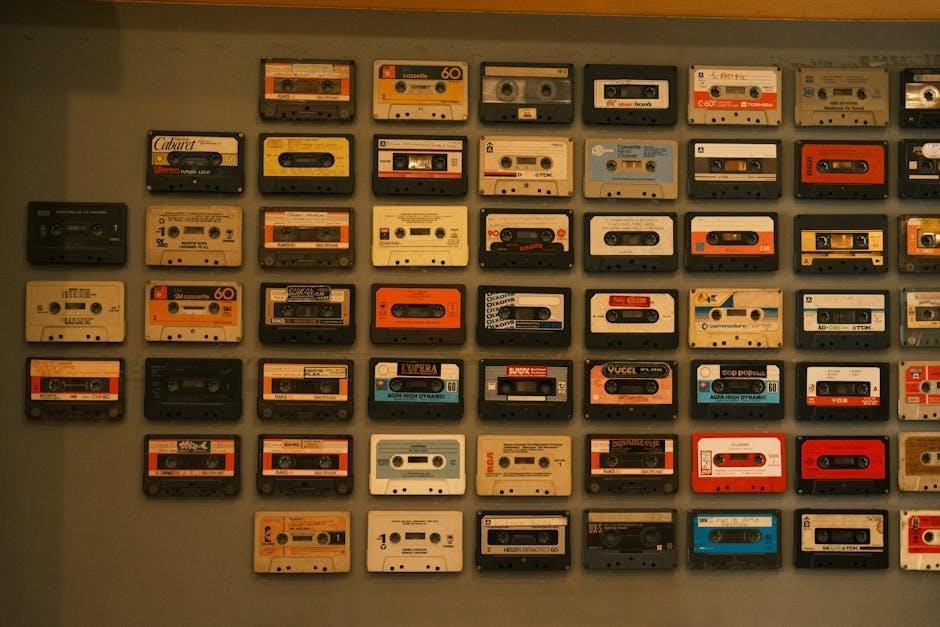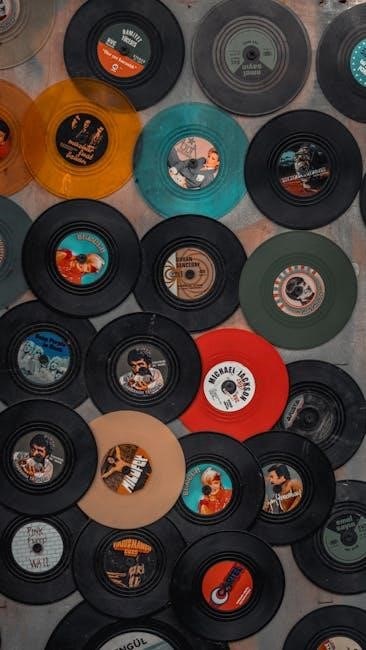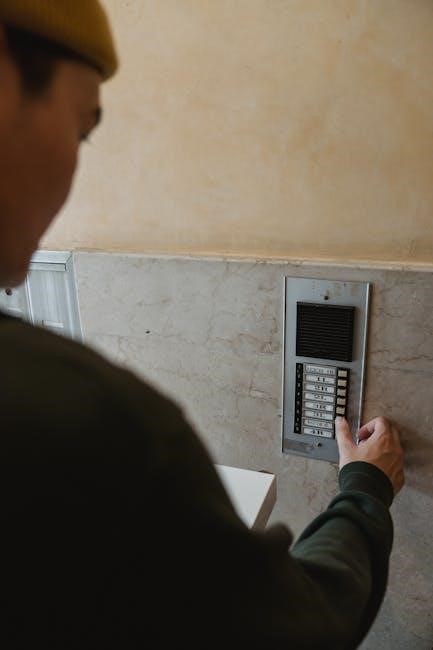sound wall cards pdf free

Sound wall cards are visual tools used to organize and teach phonics patterns, helping students connect sounds to letters and words for better reading skills.
These cards are essential for systematic phonics instruction, providing a hands-on approach to learning sound-letter relationships and word building in an engaging, interactive manner.
With free PDF resources available, educators can easily download and print sound wall cards, making them accessible for classrooms and homeschooling environments worldwide.
What Are Sound Wall Cards?
Sound wall cards are educational tools designed to help students learn and organize phonics patterns systematically. They typically feature words or sounds arranged in a specific sequence to reflect how sounds progress in language learning. These cards are often used in classrooms to teach phonological awareness and decoding skills, making complex sound relationships more visible and accessible for learners. Sound wall cards are versatile, suitable for various educational settings, including homeschooling and special education. They are usually printed on cardstock or displayed digitally, offering an interactive way to explore sounds, blends, and word families. Their structured format helps students build a strong foundation in reading and spelling skills. Free PDF versions are widely available online, making them a convenient resource for educators and parents alike.
Importance of Sound Wall Cards in Learning
Sound wall cards play a crucial role in phonics instruction by providing a systematic way to teach and organize sounds. They help students develop phonological awareness, a foundational skill for reading and spelling. By visually representing sound patterns, these cards enable learners to recognize and manipulate sounds more effectively. This tool is particularly beneficial for visual learners, as it connects sounds to written forms, reinforcing memory and understanding. Sound wall cards also support multilingual learners by clarifying sound distinctions in English. Their structured approach ensures consistency in teaching, making them an invaluable resource for educators aiming to improve literacy skills. Free PDF versions make them accessible to all.
Free PDF Resources for Sound Wall Cards
Free PDF resources for sound wall cards are widely available online, offering educators and parents a cost-effective way to implement phonics instruction. These downloadable files provide pre-designed cards that can be printed and organized according to specific sound patterns. Popular educational websites and platforms often host these resources, ensuring accessibility for classrooms and homeschooling environments. Many PDFs are customizable, allowing users to tailor cards to meet the needs of their learners. This convenience makes it easier to integrate sound wall activities into daily lessons, supporting students’ phonological awareness and reading development without additional costs.

Understanding Sound Walls

Sound walls are organized displays of sounds and phonemes, helping students visually connect sounds to letters and words, aiding in phonics and reading development effectively.

Definition and Purpose of Sound Walls
Sound walls are visual displays that organize sounds and phonemes, helping students connect sounds to letters and words for improved reading and spelling skills.
Their purpose is to provide a systematic way to teach phonics patterns, making abstract sound-letter relationships concrete and accessible for learners of all ages and skill levels.
By arranging sounds in a logical sequence, sound walls promote phonological awareness, decoding skills, and word-building abilities, serving as a foundational tool in literacy instruction and language development.
They are particularly effective in classrooms and homeschooling environments, offering an interactive and adaptable resource for educators to enhance student learning outcomes.
Free PDF resources for sound wall cards further expand accessibility, allowing teachers to easily implement this powerful educational strategy in their teaching practices.
How Sound Walls Enhance Phonological Awareness
Sound walls are powerful tools that enhance phonological awareness by visually organizing sounds and phonemes, making them tangible for students to explore and manipulate.
By arranging sounds in a logical sequence, sound walls help students identify patterns, recognize relationships between sounds, and develop a deeper understanding of how sounds combine to form words.
This visual and tactile approach engages learners, fostering their ability to segment, blend, and analyze sounds—critical skills for reading and spelling.
Free PDF resources for sound wall cards provide educators with accessible materials to implement this strategy, ensuring students can interact with sounds in a structured and meaningful way.
This systematic approach strengthens phonological awareness, laying a strong foundation for literacy development and lifelong learning.
Key Features of Effective Sound Wall Cards
Effective sound wall cards are designed with clarity and organization in mind, ensuring students can easily identify and connect sounds with their corresponding letters or patterns.
They often include visual cues, such as color-coding or images, to enhance memory and differentiation between similar sounds, making them more engaging and accessible for learners.
High-quality sound wall cards are durable, laminated, and large enough for group viewing, while also being adaptable for individual use, fostering versatility in teaching environments.
Free PDF resources for sound wall cards often include customizable templates, allowing educators to tailor them to specific phonics programs or student needs, ensuring relevance and effectiveness.
These features collectively create a robust tool that supports systematic phonics instruction and active participation, making sound walls an invaluable asset in classrooms and homeschooling settings.

Benefits of Using Sound Wall Cards
Sound wall cards enhance phonological awareness, improve reading skills, and provide accessible, free PDF resources for systematic phonics instruction, benefiting all learners.
Improved Phonics and Reading Skills
Sound wall cards are a powerful tool for enhancing phonics and reading skills by visually organizing sounds and their corresponding letters or letter patterns.

Students can easily recognize and manipulate phonemes, aiding in decoding and encoding words, which is foundational for fluent reading and spelling abilities.
Free PDF resources make these cards accessible to educators, ensuring that every classroom can benefit from systematic phonics instruction and interactive sound-based learning activities.
Enhanced Vocabulary Development

Sound wall cards play a significant role in expanding students’ vocabulary by introducing new words in a structured and visually engaging manner.
By organizing words according to sound patterns, students can easily recognize and remember words, fostering a deeper understanding of word meanings and contexts.
This approach also helps learners identify word families and prefixes/suffixes, which are crucial for decoding unfamiliar words and building a robust vocabulary base.
Free PDF resources make it easier for educators to incorporate sound wall cards into daily lessons, ensuring students develop a strong foundation for lifelong language learning and communication skills.
Support for Multilingual Learners
Sound wall cards are invaluable for multilingual learners, as they provide a visual and auditory bridge between sounds and letters, helping students connect new language patterns to their native language knowledge.
These tools simplify phonetic concepts, making them accessible to learners from diverse linguistic backgrounds, and allow teachers to address language gaps in a structured, engaging way.
Free PDF resources ensure that educators can easily implement sound wall cards in multilingual classrooms, fostering an inclusive learning environment where all students can thrive and build strong foundational language skills.
Creating Your Own Sound Wall Cards
Designing sound wall cards involves organizing phonics patterns visually, using clear fonts and colors for clarity. Teachers can customize them to suit specific learning needs and themes.
Free PDF templates simplify the process, allowing educators to print and laminate cards for durability. This hands-on approach ensures engaging and effective phonics instruction for all students.
Design Tips for Sound Wall Cards
When creating sound wall cards, prioritize clarity and readability. Use large, bold fonts and contrasting colors to ensure visibility from a distance. Incorporate visual cues like images or icons to aid memory and engagement. Organize cards by phonetic patterns or word families to promote logical learning. Ensure consistent spacing and alignment for a professional appearance. Consider adding interactive elements, such as writable surfaces for student practice. Laminate cards for durability and long-term use. Utilize free PDF templates to streamline the design process and maintain uniformity. These tips ensure sound wall cards are both functional and visually appealing, enhancing their effectiveness in phonics instruction.
Tools for Making Sound Wall Cards
Creating sound wall cards can be streamlined with the right tools. Use graphic design software like Canva or Google Slides for professional layouts. Microsoft Word and PowerPoint are also great for customizing templates. Free PDF editors like Adobe Acrobat or Smallpdf allow modifications to pre-designed cards. For educators, online platforms like Teachers Pay Teachers offer editable templates. Ensure high-quality printing with cardstock or laminators for durability. Digital tools like Google Classroom can help share and organize cards virtually. These tools make designing and distributing sound wall cards efficient and accessible, ensuring they are both visually appealing and functional for phonics instruction.
Customizing Cards for Specific Needs
Customizing sound wall cards allows educators to tailor them to meet diverse learning needs. Start by identifying the specific phonics patterns or sounds students need to master. Use free PDF templates as a base and modify them with images, colors, or additional text to enhance understanding. For visual learners, incorporate pictures to reinforce sound-letter associations. For multilingual students, include translations or bilingual text. Teachers can also add tactile elements for kinesthetic learners or create digital versions for interactive lessons. Customization ensures the cards are relevant, engaging, and accessible for all students, making phonics instruction more effective and inclusive.
Where to Find Free Sound Wall Card PDFs
Free sound wall card PDFs are available on educational websites, teacher forums, and open-source platforms. Popular sites include Teachers Pay Teachers, Google Classroom, and Pinterest.
Popular Websites for Free Educational Resources
Teachers Pay Teachers, Google Classroom, and Pinterest are top platforms for free sound wall card PDFs. These sites offer a wide range of customizable and pre-designed cards.
Teachers Pay Teachers provides diverse sound wall card sets, often created by experienced educators. Google Classroom and Pinterest allow easy searching and downloading of sound wall resources.
Additionally, Educents and Facebook teacher groups are excellent sources for free sound wall card PDFs. These platforms foster collaboration and resource sharing among educators worldwide.
By exploring these websites, teachers can access high-quality sound wall cards to enhance phonics instruction in their classrooms.
Open-Source Platforms for Sound Wall Cards
Open-source platforms like GitHub, OpenStax, and Wikimedia Commons offer free sound wall card PDFs. These platforms provide customizable and adaptable resources for educators.
GitHub repositories often include sound wall card templates designed by educators and developers. OpenStax offers free, peer-reviewed educational materials, including phonics resources.
Wikimedia Commons provides a vast library of free images and templates that can be used to create sound wall cards. These platforms promote collaboration and accessibility.
By leveraging open-source platforms, teachers can access high-quality, customizable sound wall cards without costs, ensuring equitable learning opportunities for all students.
Teacher-Created Resources and Communities
Teacher-created resources and communities are invaluable for accessing free sound wall card PDFs. Platforms like Teachers Pay Teachers (TpT) and Facebook groups offer a wealth of shared materials.
Many educators design and share sound wall cards tailored to specific phonics patterns, making them adaptable for various classroom needs. These resources often include customizable templates.
Online forums and communities provide support, allowing teachers to collaborate and exchange ideas. These platforms foster creativity and ensure high-quality, teacher-tested materials are available for free.

By leveraging these resources, educators can enhance their phonics instruction while saving time and resources, ensuring students receive engaging and effective learning tools.
Using Sound Wall Cards Effectively
Sound wall cards enhance phonological awareness by visually organizing sounds and patterns, making them easier for students to recognize and apply in reading and writing.
Interactive activities, such as sorting and matching games, engage students and reinforce sound-letter connections, promoting active learning and retention of phonics skills.
Classroom organization tips, like displaying cards prominently, ensure accessibility and encourage frequent practice, helping students build a strong foundation in phonics and literacy.
Classroom Setup and Organization
A well-organized classroom setup is crucial for maximizing the effectiveness of sound wall cards. Begin by designating a prominent, easily accessible area, such as a large bulletin board or wall, to display the cards. This ensures visibility for all students and encourages frequent interaction. Arrange the cards in a logical order, grouping similar sounds or patterns together to aid in recognition and retrieval. Use color-coded categories or labels to differentiate between vowels, consonants, and digraphs, making the wall visually appealing and user-friendly. Additionally, incorporate movable cards or interactive elements to allow students to engage hands-on with sound patterns during lessons.
For classrooms with limited wall space, consider using portable sound wall kits or digital versions accessible via tablets or laptops. This flexibility ensures that even in smaller settings, students can benefit from the sound wall’s instructional power. Regularly update the content to reflect new sounds and patterns as they are introduced, keeping the resource dynamic and relevant. By maintaining a structured yet adaptable setup, educators can create an environment that supports phonological awareness and fosters a deeper understanding of sound-letter relationships.
Interactive Activities for Sound Wall Learning
Engage students with interactive activities that leverage sound wall cards to reinforce phonological awareness and phonics skills. Begin with sound sorting games, where students match words or pictures to corresponding sounds on the wall. Incorporate scavenger hunts, asking students to find and identify words that contain specific sounds. For kinesthetic learners, use movement-based activities, such as jumping to sounds or acting out words. Group work, like building words with magnetic letters, encourages collaboration and problem-solving. These activities not only make learning fun but also deepen students’ understanding of sound patterns and their application in reading and writing.
Additionally, incorporate technology by projecting digital sound walls and having students interact with them using touchscreens or tablets. This blend of traditional and digital tools creates a dynamic learning environment that caters to diverse learning styles. Regularly rotating activities keeps lessons fresh and maintains student interest, ensuring sound wall learning remains an engaging and effective part of daily instruction.
Assessment and Progress Tracking
Regularly assess students’ understanding of sound wall patterns through informal checks and structured activities. Use exit tickets or quick quizzes to gauge mastery of specific sounds. Track progress by monitoring students’ ability to identify and apply sounds during reading and writing tasks. Maintain a progress tracking sheet to document individual and class-wide advancements. Celebrate milestones to motivate learners and provide targeted support where needed. Digital tools, such as progress tracking apps, can enhance organization and provide visual data for parents and administrators. Consistent assessment ensures sound wall instruction remains effective and tailored to student needs, fostering continuous growth in phonics and reading skills.
Advanced Tips for Sound Wall Cards
Incorporate technology, like digital sound walls, to enhance engagement. Use differentiated instruction to cater to diverse learners and encourage student participation through interactive activities and games.
Incorporating Technology with Sound Walls
Digital sound walls enhance traditional methods by offering interactive and immersive learning experiences. Teachers can use apps or online platforms to create virtual sound walls, allowing students to engage with sounds and words through touchscreens or devices. QR codes on physical sound wall cards can link to audio clips, enabling students to hear sounds and words aloud. This integration of technology makes learning dynamic and accessible, especially for hybrid or remote learning environments. Digital tools also provide opportunities for real-time feedback and progress tracking, ensuring students stay on track with their phonics development. This blend of tradition and innovation fosters a modern, engaging approach to sound wall education.
Differentiated Instruction Strategies
Differentiated instruction strategies with sound wall cards involve tailoring activities to meet diverse student needs. Teachers can group students by skill level, allowing advanced learners to explore complex patterns while supporting those needing extra practice. Visual, auditory, and kinesthetic approaches can be integrated, such as pairing cards with gestures or songs. For multilingual learners, sound wall cards can highlight phonetic similarities and differences between languages, fostering cross-linguistic connections. Additionally, incorporating technology, like digital sound walls, provides interactive and self-paced learning opportunities. These strategies ensure all students engage meaningfully, regardless of their learning style or proficiency level, promoting equitable and effective phonics instruction.
Encouraging Student Participation and Engagement
Encouraging student participation and engagement with sound wall cards involves creating interactive and inclusive learning experiences. Teachers can incorporate games, such as matching sounds to words or building phrases with cards, to make lessons dynamic. Allowing students to create their own sound wall cards fosters ownership and creativity. Group activities, like sorting sounds or role-playing as “sound detectives,” promote collaboration and teamwork. Additionally, integrating technology, such as digital sound walls or apps, can captivate tech-savvy learners. Providing opportunities for students to teach peers or share discoveries enhances confidence and motivation. These strategies ensure active involvement, making phonics learning enjoyable and effective for all students.

Troubleshooting Common Issues
Common issues with sound wall cards include printing errors, formatting problems, and outdated content. Ensure proper printer settings, use compatible PDF readers, and refresh materials regularly for optimal results.
Addressing Printing and Formatting Problems
Printing and formatting issues with sound wall cards can hinder their effectiveness. Ensure your printer settings match the PDF file’s dimensions and orientation for proper alignment. Use high-quality paper to maintain clarity. If text or images appear distorted, check the PDF for compatibility with your software. Updating your printer drivers and using the latest version of Adobe Acrobat can resolve many issues. For persistent problems, consult online forums or educational communities for troubleshooting tips tailored to sound wall cards. Regularly updating your software and hardware ensures smooth printing and formatting, keeping your sound wall cards visually appealing and functional for classroom use.
Solving Compatibility Issues with PDFs

Compatibility issues with sound wall card PDFs can arise due to outdated software or printer settings. Ensure your device has the latest version of Adobe Acrobat or a compatible PDF reader. Check that your printer drivers are updated, as outdated drivers can cause formatting errors. If PDFs appear distorted, try converting them to a different format or using online PDF repair tools. Testing the PDF on multiple devices can help identify specific compatibility problems. For persistent issues, consult the resource provider or seek solutions from educational forums. Resolving these issues ensures sound wall cards are displayed correctly, maintaining their educational effectiveness and visual appeal.
Updating and Refreshing Sound Wall Content
Regularly updating sound wall cards ensures they remain relevant and engaging for learners. Start by reviewing existing content to identify outdated or redundant cards. Replace them with new patterns or sounds to reflect evolving phonics instruction. Incorporate seasonal or thematic cards to align with classroom activities, making learning more relatable. Use digital tools to edit PDFs or create fresh designs, ensuring consistency in style and clarity. Consider adding multilingual support for diverse learners. Finally, involve students in the process, allowing them to contribute ideas or design cards, fostering ownership and deeper understanding of phonics concepts. This keeps the sound wall dynamic and effective.
Conclusion
Sound wall cards are a powerful tool for phonics instruction, offering free PDF resources to enhance learning. Their versatility and accessibility make them invaluable for educators worldwide.
Final Thoughts on Sound Wall Cards
Sound wall cards are an invaluable resource for educators, providing a structured approach to phonics instruction. Their ability to visually organize sounds and patterns makes complex concepts accessible to learners of all ages. With free PDF options widely available, teachers can easily implement these tools without additional costs. The interactive nature of sound wall cards fosters engagement and active learning, making them a cornerstone in modern educational strategies. By leveraging these resources, educators can create a dynamic and effective learning environment that supports students in mastering phonics and reading skills with confidence and clarity.
Encouragement for Continuous Learning
Embrace the journey of learning with sound wall cards, a powerful tool for phonics mastery. Free PDF resources make it easy to start, but don’t stop there—explore additional materials to deepen understanding. Encourage students to engage daily, as consistent practice builds confidence and fluency. Celebrate progress, no matter how small, to foster a love for learning. Sound wall cards are not just a teaching aid but a gateway to lifelong literacy skills. Keep exploring, adapting, and growing alongside your students, ensuring they have the tools they need to succeed in reading and beyond.
Additional Resources for Further Exploration
For deeper understanding, explore educational websites like Teachers Pay Teachers and Pinterest, which offer diverse sound wall card PDFs and creative ideas. Open-source platforms such as Google Classroom and Canva provide customizable templates, while teacher communities on Facebook and Reddit share innovative strategies. Additionally, YouTube channels dedicated to phonics instruction often feature tutorials on sound wall implementation. These resources complement free PDFs, offering a well-rounded approach to teaching and learning. By exploring these avenues, educators can enhance their sound wall practices and provide students with engaging, effective learning experiences tailored to their needs.